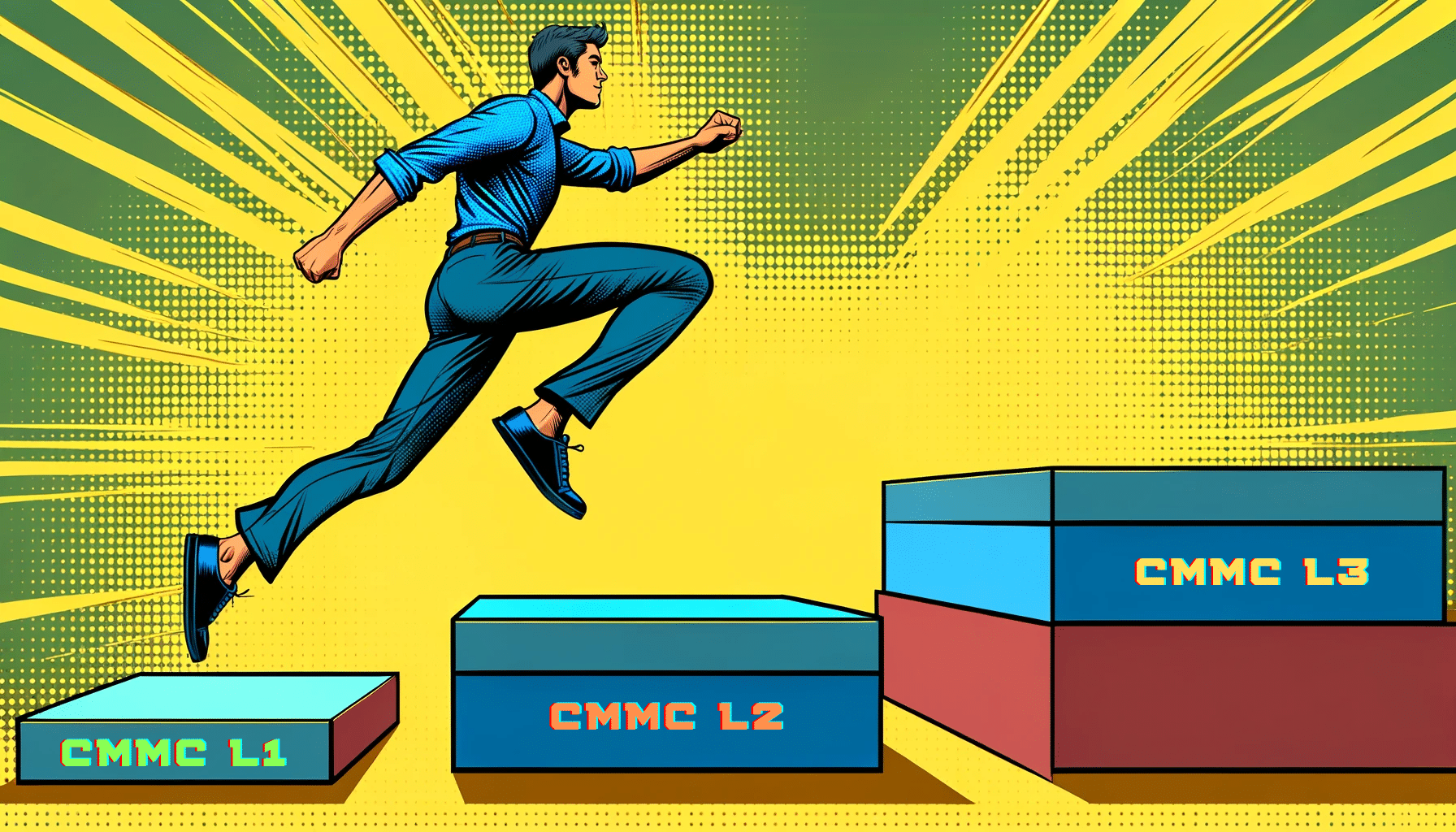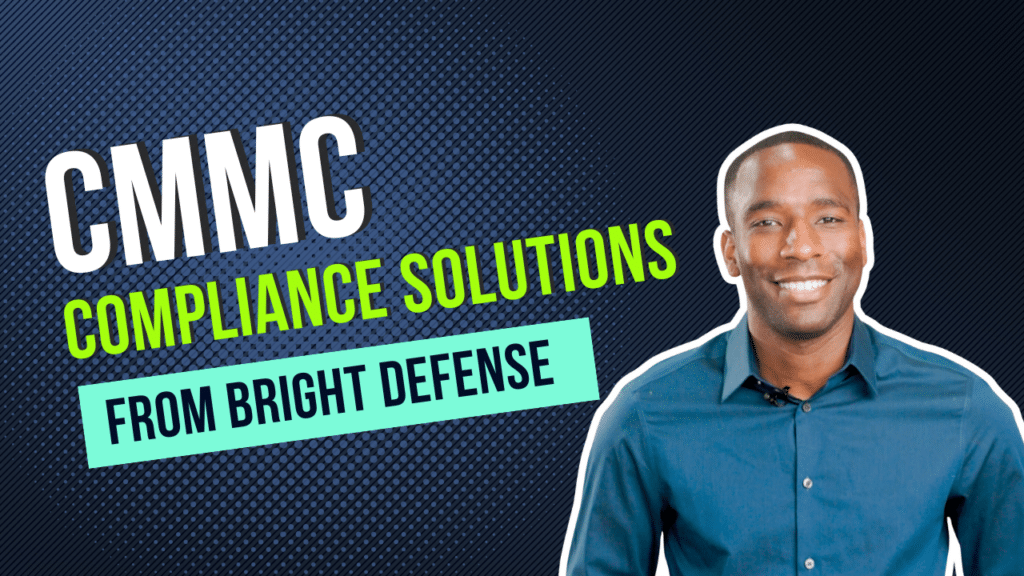
Tim Mektrakarn
February 26, 2025
Understanding CMMC Level 1: The First Step in Cybersecurity Maturity
The Cybersecurity Maturity Model Certification, better known as CMMC, is a compliance framework for bolstering cybersecurity defenses for companies doing business with the US defense supply chain. Crafted by the United States Department of Defense, CMMC establishes a detailed set of standards for implementing and evaluating cybersecurity practices within the Defense Industrial Base. CMMC Level 1 focuses on basic cyber hygiene. It’s tailored to counter a range of growing cyber threats that are targeting the defense industry.
This article focuses on CMMC Level 1. We’ll discuss its importance for your business and how to achieve Level 1 compliance. We’ll also discuss the current timeline for CMMC’s rollout, and highlight some resources you can use to stay up to date. If you are also interested in CMMC Level 2, check out our step-by-step strategy guide to CMMC Level 2 compliance.
What Is CMMC?
For business owners engaged in defense contracting, understanding CMMC is becoming essential. Developed by the United States Department of Defense (DoD), CMMC serves as a certification process that ensures defense contractors have the necessary cybersecurity measures in place to protect sensitive data. This includes Federal Contract Information (FCI) and Controlled Unclassified Information (CUI).
The CMMC framework is aimed at securing a critical part of the national supply chain. For business owners, this means implementing cybersecurity practices will be mandatory for securing future defense contracts.
Overview of CMMC Level 1: Basic Cyber Hygiene
CMMC Level 1 represents the entry point within the revised three-tiered CMMC framework. It focuses specifically on the protection of FCI. For business owners, achieving Level 1 certification is the first step towards qualifying for DoD contracts that involve handling less sensitive data. CMMC Level 1, known as “Basic Cyber Hygiene,” establishes the foundation of the comprehensive framework. It consists of 17 practices and 14 controls. These practices are the crucial minimum measures for effectively safeguarding sensitive defense information.
As the first step in the CMMC hierarchy, Level 1 plays a vital role in foundational cybersecurity, setting the stage for more advanced measures and preparing contractors for higher CMMC levels. It’s particularly vital for small and medium-sized businesses entering the defense supply chain, offering a manageable starting point to build a robust cybersecurity framework.
The Three Proposed Levels of CMMC
Brief Overview of the CMMC Framework
- CMMC Level 1 – Foundational: This level focuses on basic cyber hygiene practices to protect Federal Contract Information (FCI). It establishes fundamental cybersecurity controls that are essential for all contractors within the DIB.
- CMMC Level 2 – Advanced: Aimed at safeguarding Controlled Unclassified Information (CUI), this intermediate level enhances the basic cyber hygiene from Level 1 with more sophisticated cybersecurity practices and processes.
- CMMC Level 3 – Expert: Designed for organizations managing highly sensitive defense information, this highest level demands the strictest cybersecurity measures, encompassing a comprehensive and proactive cybersecurity program.
CMMC Rule Making Process and Current Timeline
- The CMMC framework is undergoing a rule-making process, which involves public commentary and finalization stages. This process ensures that the framework is comprehensive, practical, and attuned to the evolving cyber threat landscape.
- At the time of writing this article, the DoD is working on finalizing these revisions, with an anticipated rollout of the updated CMMC 2.0 framework. Defense contractors should proactively start aligning their cybersecurity practices with the proposed changes, even while the rule-making process is ongoing, as the implementation timeline depends on its completion.
Timeline Highlights:
- November 2021: CMMC 2.0, a revised and streamlined version of the original model, is announced with an estimated rulemaking timeframe of 9-24 months.
- March 2023: The DoD submits the proposed CMMC rule to the Office of Management and Budget (OMB) for regulatory review.
- November 2023: The regulatory review process concludes, paving the way for the rule’s publication.
- December 25, 2023: The proposed CMMC rule is published in the Federal Register, triggering a 60-day public comment period.
- Early 2024: (Tentative) The DoD addresses public comments and issues a final CMMC rule.
- Q1 2025: (Estimated) CMMC requirements begin appearing in new DoD contracts.
Next Steps
As the DoD prepares to release the proposed rule soon, stakeholders should actively analyze its specifics and prepare to offer thoughtful feedback during the public comment period. The DoD will consider this feedback to refine the rule before issuing its final version. Once finalized, the DoD will gradually incorporate CMMC requirements into new contracts, expecting a phased implementation over several years.
To get the latest information on CMMC timelines, you can check a few key sources:
- Official CMMC Accreditation Body Website: This site often contains the most accurate and up-to-date information regarding CMMC implementation phases, training, and certification timelines.
- U.S. Department of Defense (DoD) Website: Look for press releases, updates, and official guidelines regarding CMMC on the DoD’s official website or specific pages dedicated to cybersecurity and defense contracting.
- Industry Publications and News Sites: Websites like FedScoop and Defense News often report on updates to government contracting requirements and frameworks like CMMC.
- Webinars and Conferences: Many cybersecurity and defense contracting conferences discuss CMMC. Attending these or viewing recorded sessions can provide insights into current expectations and future roadmap plans.

Detailed Analysis of CMMC Level 1
CMMC Level 1, often referred to as “Basic Cyber Hygiene,” is the foundational tier in the Cybersecurity Maturity Model Certification framework. It’s designed to safeguard Federal Contract Information (FCI) within the networks of the Defense Industrial Base (DIB). This level is crucial for establishing a baseline of cybersecurity practices that are essential for all contractors, especially those new to working with the Department of Defense (DoD).
Objectives of Level 1
- Protect FCI: The primary objective is to ensure the protection of Federal Contract Information, which is not intended for public release.
- Establish Basic Cybersecurity Hygiene: To inculcate fundamental cybersecurity practices and behaviors within the organization.
- Foundation for Higher Levels: Level 1 serves as a stepping stone for advancing to higher CMMC levels, with more stringent cybersecurity requirements.
Key Focus Areas
- Basic Cybersecurity Measures: Implementing essential security controls to protect against common cyber threats.
- User Awareness and Training: Educating employees about basic cybersecurity practices and potential cyber threats.
- Physical Security: Ensuring physical safeguards are in place to protect hardware and information systems.
What is FAR 52.204-21?
Achieving CMMC Level 1 compliance starts with implementing the 15 requirements of FAR 52.204-21, known as “Basic Safeguarding of Covered Contractor Information Systems,” is a clause within the Federal Acquisition Regulation (FAR). This clause is integral to the U.S. government’s efforts to ensure that contractors protect the confidentiality, integrity, and availability of information. This applies directly to federal contractors and subcontractors dealing with Federal Contract Information (FCI), defined as information not meant for public release, either provided to or generated for the Government under a contract.

Key aspects of FAR 52.204-21 include:
- Scope: This clause applies to all contractors and subcontractors that process, store, or transmit Federal Contract Information. It sets out basic requirements for safeguarding that information within contractor information systems.
- Safeguarding Requirements: The clause outlines 15 specific security requirements for protecting FCI. These requirements are similar to those found in the NIST (National Institute of Standards and Technology) SP 800-171, but they are less comprehensive. They include measures for limiting information system access, ensuring secure authentication, monitoring, controlling, and protecting information transmitted or stored, and responding to incidents.
- Implementation: Contractors tasked with handling Federal Contract Information (FCI) must implement safeguards that correspond to the associated risk level. While this allows some flexibility in the application of these requirements, the key goal is to ensure adequate protection of FCI.
- Compliance: Adhering to FAR 52.204-21 is not optional but a mandatory compliance for these contractors. Often, it’s a prerequisite for securing federal contracts. Non-compliance could result in serious consequences, including penalties and potential loss of contracts.
The 15 requirements of FAR 52.204-21
The following is copied verbatim from https://www.acquisition.gov/far/52.204-21
- (i) Limit information system access to authorized users, processes acting on behalf of authorized users, or devices (including other information systems).
- (ii) Limit information system access to the types of transactions and functions that authorized users are permitted to execute.
- (iii) Verify and control/limit connections to and use of external information systems.
- (iv) Control information posted or processed on publicly accessible information systems.
- (v) Identify information system users, processes acting on behalf of users, or devices.
- (vi) Authenticate (or verify) the identities of those users, processes, or devices, as a prerequisite to allowing access to organizational information systems.
- (vii) Sanitize or destroy information system media containing Federal Contract Information before disposal or release for reuse.
- (viii) Limit physical access to organizational information systems, equipment, and the respective operating environments to authorized individuals.
- (ix) Escort visitors and monitor visitor activity; maintain audit logs of physical access; and control and manage physical access devices.
- (x) Monitor, control, and protect organizational communications (i.e., information transmitted or received by organizational information systems) at the external boundaries and key internal boundaries of the information systems.
- (xi) Implement subnetworks for publicly accessible system components that are physically or logically separated from internal networks.
- (xii) Identify, report, and correct information and information system flaws in a timely manner.
- (xiii) Provide protection from malicious code at appropriate locations within organizational information systems.
- (xiv) Update malicious code protection mechanisms when new releases are available.
- (xv) Perform periodic scans of the information system and real-time scans of files from external sources as files are downloaded, opened, or executed.

Key Steps in Preparation for CMMC L1
Conducting a Self-Assessment:
- Begin by thoroughly reviewing the 15 requirements for CMMC L1 based on FAR 52.204-21. These practices focus on basic cyber hygiene.
- Assess your current cybersecurity practices against these standards. This means checking how your existing security measures align with the CMMC requirements.
Identifying Gaps:
- During the self-assessment, identify any areas where your current cybersecurity practices fall short of CMMC standards. These are your ‘gaps.’
- Prioritize these gaps based on their potential impact on your cybersecurity posture.
Implementing 17 Practices of Level 1
- Develop a plan to address each identified gap. This may involve implementing new security measures or enhancing existing ones.
- Ensure that all the CMMC Level 1 practices are effectively implemented in your organization.
- Access Control: Limiting access to FCI to authorized users. This includes implementing controls to restrict who can view, modify, or use company data. Implementing password-protected user accounts, with each employee having a unique login credential.
- Identification and Authentication: Ensuring that users accessing the system are who they claim to be. This involves secure login processes and user verification methods. Using multi-factor authentication (MFA) for accessing sensitive systems and information.
- Media Protection: Safeguarding digital and physical media that contain FCI. This includes secure storage and disposal of media. Employing secure storage for USBs, hard drives, and other media containing FCI, and establishing procedures for safely disposing of obsolete media.
- Physical Protection: Implementing measures to protect hardware, software, and data from physical threats. This includes secured facilities and protection against environmental hazards. Install secure locks on doors, use badge access systems, and implement visitor logs in areas where sensitive information is handled.
- System and Communication Protection: Ensuring the security of information communicated over networks and protecting the underlying infrastructure. Employing firewalls and secure Wi-Fi networks to protect data in transit.
- System and Information Integrity: Maintaining the integrity of systems and information, including protecting against malware and monitoring for cyber threats. Regularly updating antivirus software, conducting periodic system scans, and training staff to recognize and report potential cyber threats.

Remediation and POA&Ms
Plan of Action and Milestones (POA&M)
Section 170.21 of the CMMC (Cybersecurity Maturity Model Certification) guidelines focuses on the Plan of Action and Milestones (POA&M), which is like a to-do list for improving your cybersecurity. Here’s what you need to know about it:
What is a POA&M?
- It’s a plan that outlines how you will address and fix any shortcomings in your cybersecurity practices.
CMMC Level 1 – No POA&M Allowed:
- If you’re aiming to meet Level 1 requirements of CMMC, you can’t use a POA&M. This means you need to have all the necessary cybersecurity measures already in place and fully operational at the time of your assessment.
Level 2 – POA&M Allowed with Conditions:
- For Level 2, you can have a POA&M, but there’s a catch. You must complete all the actions in your POA&M within 180 days of your initial assessment.
- There are also certain key security requirements that you need to meet right away, without relying on a POA&M.
Level 3 – POA&M Allowed:
- Similar to Level 2, a POA&M is allowed for Level 3. You have to finish all the actions in your POA&M within 180 days of your assessment.
- Like Level 2, there are certain critical security measures that you must have in place from the start, without depending on a POA&M.
Scoring and Specific Requirements:
- Section 170.21 also talks about the minimum score you need to achieve in your assessment for Levels 2 and 3.
- It specifies which security requirements at these levels are so important that you can’t put them off into a POA&M.
Rules for Closing POA&Ms:
- There are specific rules on how and when you need to close out your POA&M. This is important to ensure you’re keeping up with your cybersecurity improvements.
Documentation and Evidence Gathering:
- Document each step of your compliance process. This includes records of the implemented practices and the procedures followed.
- Prepare evidence that demonstrates your compliance with each of the CMMC Level 1 practices. This evidence will be crucial for your self-assessment and any future audits.
Seeking Assistance from Accredited Bodies
- Understanding the Role of Accredited Bodies:
- Accredited bodies are organizations recognized by the CMMC Accreditation Body (CyberAB) to provide assessment, consulting, and certification services.
- They can offer guidance and support throughout the preparation and assessment process.
- Consulting for Preparation:
- Consider consulting with a CyberAB recognized provider like Bright Defense to help you understand the requirements and prepare for certification.
- These providers can offer insights into best practices, help identify gaps, and guide you on how to address them.
- Assessment and Certification:
- While Level 1 usually involves a self-assessment, getting your assessment validated by an accredited body can add credibility to your certification.
- They can provide a thorough review and confirm that you meet all the Level 1 requirements.
Preparing for CMMC Level 1 certification involves a detailed self-assessment, gap analysis, implementation of required practices, and diligent documentation. Seeking assistance from accredited bodies can provide additional support and validation of your efforts. This preparation not only helps in achieving certification but also strengthens your cybersecurity foundation, a crucial aspect for any business working with the federal government.
Annual Assessment of Requirements
At the basic Level 1 of CMMC (Cybersecurity Maturity Model Certification), if you’re a contractor or a subcontractor of a prime that works with the government, you need to check yourself every year to make sure you’re following the security rules listed in a specific government clause, FAR clause 52.204–21. This is like a DIY check-up to ensure you’re keeping all the necessary cybersecurity measures in place. Once you’ve done this check-up, you have to put your results into an online system called the Supplier Performance Risk System (SPRS). The specifics about how to do this self-assessment and what exactly you need to report can be found in a particular section of the CMMC guidelines, § 170.15. Look especially at section § 170.15(a)(1)(i) for what information you need to gather and report.

Common Misconceptions about CMMC Level 1
Navigating the complexities of the Cybersecurity Maturity Model Certification (CMMC) can be challenging, and there are several misconceptions about Level 1 that need clarification.
A. Debunking Myths
- Myth: “Level 1 is too basic to be effective.”
- Reality: While Level 1 is the foundational level, it establishes essential cybersecurity practices. These practices are critical for protecting Federal Contract Information (FCI) and form the basis for more advanced cyber hygiene.
- Myth: “Once I’m certified at Level 1, I don’t need to worry about cybersecurity anymore.”
- Reality: Achieving Level 1 certification is just the beginning. Cyber threats are constantly evolving, and continuous vigilance and improvement are necessary.
- Myth: “CMMC Level 1 is only for big companies.”
- Reality: CMMC Level 1 is designed for businesses of all sizes, including small and medium-sized businesses. It’s a manageable starting point for smaller companies entering the defense supply chain.
B. Clarifying Common Misunderstandings
- Misunderstanding: “CMMC Level 1 certification process is lengthy and complex.”
- Clarification: The process for Level 1 is relatively straightforward compared to higher levels. It primarily involves a self-assessment against 17 basic cybersecurity practices.
- Misunderstanding: “Compliance with Level 1 is voluntary.”
- Clarification: Compliance with CMMC Level 1 is mandatory for contractors who handle FCI. It’s a federal requirement for doing business with the DoD.
- Misunderstanding: “I need to hire an external auditor for Level 1 certification.”
- Clarification: Level 1 typically involves a self-assessment, not an external audit. However, it’s crucial to honestly evaluate and implement the required practices.
- Misunderstanding: “Implementing CMMC Level 1 is expensive.”
- Clarification: The cost can vary, but since Level 1 focuses on basic cyber hygiene, many of the practices may already be part of your existing operations. For many businesses, the cost is not prohibitive.
- Misunderstanding: “CMMC Level 1 covers all aspects of cybersecurity.”
- Clarification: Level 1 provides basic safeguards but does not cover all aspects of cybersecurity. Businesses should view it as a starting point and consider additional measures for comprehensive protection.
Understanding these truths about CMMC L1 helps businesses approach the certification with accurate expectations and adequate preparation. It’s essential to see Level 1 as an important step in building a strong cybersecurity foundation, critical for the protection of sensitive information and the integrity of the defense supply chain.
Bright Defense CMMC L1 Services
Bright Defense is here to guide you through every step of the process. Our expert team specializes in CMMC Level 1 consulting, ensuring that you meet the essential cybersecurity requirements set by the Department of Defense. We’ll help you conduct a thorough self-assessment, identify and address any gaps in your cybersecurity practices, and assist in the implementation of the required practices. Plus, we provide comprehensive documentation and evidence gathering support. Bright Defense will also present you a certificate of completion once we have validated the requirements of CMMC Level 1 has been met.
Don’t navigate the complexities of CMMC Level 1 alone. Contact Bright Defense today to secure your path to compliance and safeguard your business against evolving cyber threats. Let us be your partner in achieving and upholding the critical cybersecurity standards required for federal contracting. Reach out now to learn more about our services and how we can help your business thrive in a secure digital environment.
Get In Touch



